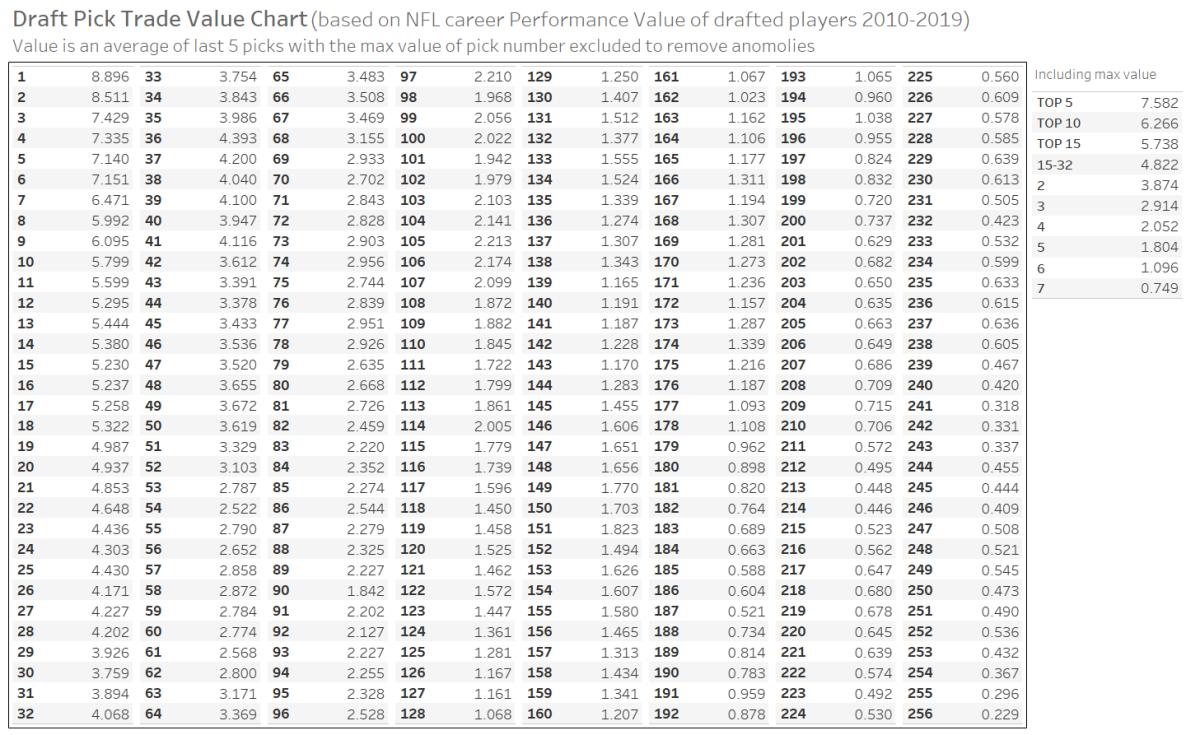Analytics: True Cost of Trading Up in Draft Should Give Broncos Significant Pause
There has been serious speculation about the Denver Broncos trading up in the first round of the NFL Draft to ensure they get the desired prospect. However, moving up in the first round costs the team serious draft capital.
In fact, it costs significantly more than one might think.
Jimmy Johnson is credited for creating the 'Draft Trade Value Chart' when he was building the Dallas Cowboys dynasty as the head coach back in the early 1990s. Johnson is a football genius and has forgotten more about football than I will ever know.
His input in creating this chart is immeasurable. This chart has been used in some form or another by draft personnel, internet draftniks, and fans for nearly three decades.
There was plenty of research that went into this chart by some great football minds. When you look at the value chart it, is simply a series of declining numbers starting at 3000 with pick No. 1 and ending at 2 with the final pick in round seven.
The numbers decline in a specific pattern for the most part and when scrutinized closely, they seem, for lack of a better word, arbitrary. The first few selections decline by 100, then the mid-first round selection decline by 50, then by 25, and so on until the last few picks decline by 1.
Again, this was a chart created by fantastic football minds, so I do not want to take anything away from what they created. It was a great tool to use when no such tool existed.
What it doesn’t take into account is the actual NFL performance of the players selected at each of the picks throughout the draft. It also is 30 years old.
The NFL game and the draft process have changed significantly over that time. In reality, what it takes to move up changes year to year, based on what teams are willing to take for that move.
The market value of draft picks is determined by the teams involved. Maybe it is time for an upgraded chart based on the value those picks represented in actual performance on an NFL field.
With the amount of NFL data captured over the past decade, there are many ways to evaluate the careers of each draft selection. One of them is to use a metric that I have used many times in the past — Pro Football Reference's Performance Value Car AV.
It's a performance metric averaged across every season of a player’s career. I have taken every player drafted since 2011 and put them into a database.
With this database, I have performed analytics on every selection in the last 10 drafts to provide a value that each player chosen at each pick represents. This value represents all those player’s NFL careers taken at that specific pick.
The results are surprising. They are surprising because of the amount of value that a team gives up when trading picks to move up a few slots in the first round of the draft.
A More Accurate Modern Draft Value Chart
The following chart is the average PV for each pick, but with the max value removed (to exclude anomalies) and averaged over the last five picks to smooth out the highs and lows.

Instead of starting at 3000 and subtracting a set value to move to the final pick, it is a reflection of all the players selected at that pick number and their PV for their actual NFL career. The biggest difference is that the lower picks hold more comparative value than the original value chart.
The final selection in this PV chart is 2.5% of the value of the first selection while the last selection in the original is 0.07% of the first. Meaning, selections later in the draft carry more weight in reality than the original draft chart reflects.
What it Would Really Cost Broncos to Move Up
Now, let’s take a look at what it actually costs to move up in the draft. First, the draft is not an exact science. This previous analysis indicates that the more selections you have the more advantageous for teams selecting.
Since having more picks is valuable, trading them away is not ideal. That in and of itself makes trading away picks a significant loss of value. The actual value lost in each pick represents in NFL performance is eye-opening.
For example, if the rumors are correct, the Denver Broncos are looking to trade up from No. 15 to 10. One only needs to look at 2018 for a reference point.
That draft season, the Arizona Cardinals moved from 15 to 10 to select UCLA QB Josh Rosen. The Cardinals gave up the picks 15, 79, and 152 to move up those five spots.
By using the updated chart above, the Cardinals gave up 4.129 in PV to gain 0.529 in PV. That doesn’t seem like a great trade-off in value. The Broncos would have to do something similar in order to move up.
John Elway would likely need to give up Denver's picks No. 77 and 118 selections, but for sake of argument, let’s say the Broncos only needed to give up 77 and 178. Those two picks represent 4.059 in PV. That is significant lost value for gaining only 0.529.
In reality, the Cardinals trade became Rosen for the Cardinals and UCLA OT Kolton Miller, USC DL Rasheem Green, and Arizona S Dane Cruikshank for a different team. In PV alone, Miller represents 7.5, Green 2.5, and Cruikshank 1 for a total of 11 value points.
Rosen hasn’t been given much of a chance to succeed in the NFL, but if we compare him to another franchise quarterback selected in that same draft, Wyoming's Josh Allen (PV 8.5), we can easily see that the PV of those three players is greater.
Allen was taken by the Buffalo Bills earlier than Rosen and has played significantly more. Miller is a starting left tackle and Green came on last season by getting four sacks at the defensive tackle position while starting eight games. Cruikshank is a reserve, but has played in 28 games. A fifth-round player who contributes as a role player has value.
The Cardinals traded up to get their quarterback (even if he ended up not being the guy) so the trade made some sense. Quarterbacks are a valuable commodity. The Broncos don’t need to get a quarterback, though, so that alone diminishes the return on the investment. Literally, out of the gates.
Since the Broncos will not be trading up for a quarterback, the value of the position they're targeting is less. If it is for a wide receiver as rumor suggests, there is one comparison from the 2017 draft — Clemson's Mike Williams.
Williams was taken at the No. 7 spot and his PV is 7.5. He's a good wide receiver, but has presented less value than that of Allen. Therefore, if the Broncos indeed traded up to pick 10, they'd be taking a less-valuable position than the Cardinals did while giving away similar value.
Bottom Line
Trading up in the draft is an exercise in lost value. A tremendous amount of lost value.
If the Broncos needed just one player to get them over the hump and to the Super Bowl, it would make some sense. However, they have holes in more than one part of their roster.
Frankly, it's not worth the investment and the Broncos would be wise to stay put and take the best player that falls to them. As Nick Kendell broke down on Monday, considering what is sure to be a run on quarterbacks in the top-10, the odds of the Broncos standing pat at 15 and landing one of the Terrific 12 prospects are good.
Follow Thomas on Twitter @ThomasHallNFL and @MileHighHuddle.
